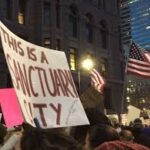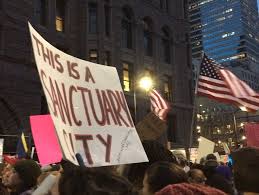Sanctuary cities in the United States represent a controversial and complex topic situated at the crossroads of immigration policy, local governance, and federal law. These cities have adopted policies, ordinances, or declarations that limit local cooperation with federal immigration enforcement agencies, with the intent of fostering a safer environment for undocumented immigrants. The debate around sanctuary cities is multifaceted, touching upon issues of public safety, human rights, federalism, and the broader discourse on immigration reform. This essay explores the origins, implications, and controversies surrounding sanctuary cities in the U.S., providing a comprehensive overview of their role within the nation’s immigration landscape.
Origins and Evolution
The concept of “sanctuary” has deep historical roots, but its modern application to cities in the U.S. began in the 1980s as part of the Sanctuary Movement. This movement was a response to the influx of refugees fleeing civil conflicts in Central America, many of whom were denied asylum in the U.S. Churches, and eventually cities, declared themselves sanctuaries, offering protection and support to these refugees. Over time, the idea evolved to encompass municipal policies aimed at reducing the fear of deportation and potential family separation for undocumented immigrants living within these cities.
Policies and Practices
Sanctuary cities implement a variety of policies that generally seek to establish a separation between local law enforcement and federal immigration authorities. Common practices include prohibiting local police from asking about an individual’s immigration status during stops or interactions, refusing to hold individuals solely on the basis of a federal immigration detainer request, and limiting the sharing of information about release dates or home addresses with federal agencies. The goal is to encourage undocumented immigrants to report crimes, access health and social services, and participate in community life without fear of deportation.

Arguments For and Against
Supporters argue that sanctuary cities enhance public safety by building trust between immigrant communities and law enforcement, encouraging crime reporting, and witness cooperation. They also view these policies as a defense of human rights, protecting undocumented immigrants from family separation and ensuring access to essential services.
Critics, however, claim that sanctuary cities can harbor criminals, undermine federal immigration law, and pose a threat to public safety. They argue that these policies prevent the removal of undocumented immigrants who commit crimes, thus endangering the community at large.
Legal and Political Controversies
Sanctuary cities have been at the center of numerous legal and political battles. The federal government, under various administrations, has attempted to withhold federal funding from sanctuary jurisdictions, arguing that they obstruct the enforcement of national immigration laws. These efforts have led to legal challenges, with courts often siding with sanctuary cities on the grounds of states’ rights and the separation of powers.
The clash between local and federal authorities raises significant questions about federalism and the extent of federal power over local governance. It also highlights the broader political divide over immigration policy in the United States, reflecting deep-seated disagreements about how to balance enforcement with compassion and the integration of undocumented immigrants into American society.
The Road Ahead
As the national debate on immigration continues, sanctuary cities remain a flashpoint. These jurisdictions embody a commitment to inclusivity and protection for undocumented immigrants, but they also face significant challenges, both legally and politically. The future of sanctuary cities will likely depend on broader shifts in U.S. immigration policy, public opinion, and the outcomes of ongoing legal battles. What remains clear is that the issue of sanctuary cities is more than just a policy debate; it is a reflection of the nation’s struggle to define its identity, values, and responsibilities in an increasingly complex and globalized world.

Economic Implications
Sanctuary cities contribute to the local economy in several significant ways. By allowing undocumented immigrants to participate more fully in the community and economy, these cities benefit from increased labor participation, entrepreneurship, and tax contributions. Immigrants, including those undocumented, play a crucial role in filling labor shortages, especially in industries like agriculture, construction, and services. Moreover, the economic activity generated by immigrant communities contributes to the vibrancy and growth of local economies.
However, critics of sanctuary policies argue that they could potentially attract more undocumented immigrants, thereby increasing competition for low-skilled jobs and placing additional strains on public resources and services. Balancing these economic impacts requires nuanced policies that acknowledge the contributions of immigrants while addressing legitimate concerns about resource allocation and social services.
Social Cohesion and Integration
Sanctuary cities aim to foster a sense of belonging and participation among undocumented immigrants by reducing the fear of deportation. This inclusive approach supports the integration of immigrants into the social fabric of their communities, promoting diversity and multicultural understanding. Social integration benefits not only immigrants but also the broader community, as it leads to stronger, more cohesive societies.
Yet, this approach is not without its challenges. The sanctuary city designation can sometimes lead to social tensions, particularly in areas where immigration is a contentious issue. Misinformation and misconceptions about sanctuary policies and their implications can exacerbate these tensions, highlighting the need for clear communication and community engagement efforts.
National Security and Public Safety
One of the most heated debates around sanctuary cities concerns their impact on national security and public safety. Supporters contend that by encouraging cooperation between immigrant communities and local law enforcement, sanctuary cities actually enhance public safety. They argue that when immigrants trust their local police, they are more likely to report crimes, cooperate with investigations, and provide valuable intelligence that can prevent future crimes.
Conversely, opponents assert that sanctuary policies prevent the federal government from effectively enforcing immigration laws, potentially allowing dangerous individuals to remain in the country. This argument often points to high-profile cases where undocumented immigrants committed serious crimes as evidence that sanctuary policies may compromise public safety.

Legal Battles and the Future of Sanctuary Cities
The legal landscape surrounding sanctuary cities is complex and constantly evolving. The crux of the issue lies in the conflict between federal immigration enforcement and local autonomy. Sanctuary policies have been challenged in court, with key questions about the extent of federal authority over local jurisdictions and the constitutionality of withholding federal funds as a means to compel local cooperation with federal immigration enforcement.
As the United States grapples with these questions, the future of sanctuary cities remains uncertain. The ongoing legal battles and legislative efforts at both the state and federal levels are likely to shape the policies and practices of sanctuary cities in the years to come.
Conclusion
Sanctuary cities encapsulate the multifaceted challenges and opportunities presented by immigration in the United States. As sites of struggle over federalism, human rights, and national identity, they highlight the deep divisions as well as the potential for compassion and solidarity within American society. Moving forward, the debate over sanctuary cities will continue to reflect broader conversations about who is considered an American, the rights and responsibilities of local versus federal governments, and how best to integrate a diverse population into the fabric of the country. As such, sanctuary cities will remain at the heart of America’s ongoing dialogue about its values, policies, and identity in an increasingly interconnected world. Sanctuary cities in the USA are a testament to the country’s ongoing discourse on immigration, human rights, and the balance of power between local and federal governments. As this debate unfolds, the experiences of sanctuary cities offer important lessons on community safety, integration, and the enduring importance of welcoming spaces in American society.



